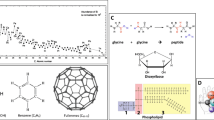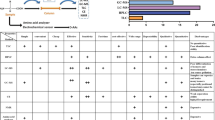Summary
The uptake of Ca45 into cells of the dinoflagellateGlenodinium foliaceum was investigated using insoluble compound light microscope autoradiography. The distribution of silver grains showed marked localisation to the dinocaryotic nucleus, with a random scatter of grains over the surrounding protoplasm (cytoplasm and supernumerary nucleus). Correction of grain counts for lateral sensitisation from the dinocaryotic nucleus indicated an isotope concentration 16–32 times greater in this organelle compared to the rest of the cell.
Cells labelled for varying periods of time showed differences in the pattern of Ca45 uptake throughout the sample populations, but no increase in the mean level of uptake per cell. This would suggest a rapid incorporation of isotope within 1–2 hours, with little subsequent uptake. The presence of high levels of label after processing with both additive (glutaraldehyde, paraformaldehyde) and coagulative (acetic alcohol) fixatives indicated that the retention of Ca45 in these preparations was not simply a fixation artefact.
Although the isotope did not appear to be suitable for (high resolution) electron microscope autoradiography, the intranuclear site of incorporation was demonstrated indirectly using a buffer extraction technique. Prolonged treatment with phosphate buffer resulted in a large scale loss of label from both cytoplasm and dinocaryotic nucleus. The latter appeared to show specific correlation with the loss of (protein) matrix from the chromosomes — as observed under both light and electron microscopy, with no apparent change in either nucleolus or nucleoplasm. This would suggest that incorporated Ca45 in the nucleus was largely confined to the condensed chromatin, where it was combined with the acidic proteins which make up the bulk of the chromatin matrix.
The results obtained in this investigation are related to previous studies involving X-ray microanalysis and uptake of Ni63.
Similar content being viewed by others
References
Bachmann, L., Salpeter, M. M., 1965: Autoradiography with the electron microscope: a quantitative evaluation. Lab. Invest.14, 1041.
Caro, L. G., Schnos, M., 1965: Tritium and phosphorus-32 in high resolution autoradiography. Science (Washington)149, 60.
Dodge, J. D., 1971: A dinoflagellate with both a mesocaryotic and a eucaryotic nucleus. 1. Fine structure of the nuclei. Protoplasma73, 145–157.
Duncan, C. J., 1976: Calcium in Biological Systems. Soc. for Exp. Biol. Volume XXX.
Grassé, P. P., Dragesco, J., 1957: L'ultrastructure du chromosome des péridiens et ses conséquences génétiques. C. R. hebd. Seanc. Acad. Sci. Paris245, 1447–2451.
Howell, S. L., Tyhurst, M., 1976:45Calcium localisation in islets of Langerhans, a study by electron microscope autoradiography. J. Cell Sci.21, 415–422.
Kearns, L. P., Sigee, D. C., 1979: High levels of transition metals in dinoflagellate chromosomes. Experientia35, 1332–1333.
— —, 1980: The occurrence of period IV elements in dinoflagellate chromatin: an X-ray microanalytical study. J. Cell Sci.46, 113–127.
Means, A. R., Dedman, J. R., 1980: Calmodulin — an intracellular Calcium receptor. Nature285, 73–78.
Peters, T., Ashley, C. A., 1967: An artefact in radioautography due to binding of free amino acids to tissues by fixatives. J. Cell Biol.33, 53–60.
Rizzo, P. J., Nooden, L. D., 1973: Isolation and chemical composition of dinoflagellate nuclei. J. Protozool.20, 666–672.
— —, 1974 a: Isolation and partial characterisation of dinoflagellate chromatin. Biochim. biophys. Acta349, 402–414.
— —, 1974 b: Partial characterisation of dinoflagellate chromosomal proteins. Biochim. biophys. Acta349, 415–427.
Salpeter, M. M., Salpeter, E. E., 1971: Resolution in electron microscope autoradiography. II Carbon14. J. Cell Biol.50, 324–332.
Saubermann, A. J., Echlin, P., 1975: The preparation, examination and analysis of frozen hydrated tissue sections by scanning transmission electron microscopy and X-ray microanalysis. J. Microscopy105, 155–191.
Seveus, L., Brdiczka, D., Barnard, T., 1978: On the occurrence and composition of dense particles in mitochondria in ultrathin frozen dry sections. Cell Biol. int. Rep.2, 155–162.
Sigee, D. C., 1982: Localised uptake of63Nickel into dinoflagellate chromosomes: an autoradiographic study. Protoplasma110, 112–120.
—,Kearns, L. P., 1981 a: X-ray microanalysis of chromatin-bound period IV metals inGlenodinium foliaceum: a binucleate dinoflagellate. Protoplasma105, 213–223.
— —, 1981 b: Nuclease extraction of chromosome-bound metals in the dinoflagellateGlenodinium foliaceum: an X-ray microanalytical study. Cytobios31, 49–66.
— —, 1981 c: Levels of dinoflagellate chromosome-bound metals in conditions of low ion availability: an X-ray microanalytical study. Tissue and Cell13, 441–451.
— —, 1982 a: Differential retention of proteins and bound divalent cations in dinoflagellate chromatin fixed under varied conditions: an X-ray microanalytical study. Cytobios33, 51–64.
— —, 1982 b: X-ray microanalysis of unfixed chromatin in dinoflagellate cells prepared by a monolayer cryotechnique. J. biochem. biophys. Methods6, 23–30.
Spurr, A. R., 1969: A low viscosity resin embedding medium for electron microscopy. J. Ultrastruct. Res.26, 31–43.
Tomas, R. N., Cox, E. R., 1973: Observations of the symbiosis ofPeridinium balticum and its intracellular alga. 1. Ultrastructure. J. Phycol.9, 304–323.
—,Steidinger, K. A., 1973:Peridinium balticum (Levander) Lemmermann, an unusual dinoflagellate with a mesocaryotic and a eucaryotic nucleus. J. Phycol.9, 91–98.
Author information
Authors and Affiliations
Rights and permissions
About this article
Cite this article
Sigee, D.C. Localised uptake and extraction of Calcium45 in dinoflagellate nuclei: an autoradiographic study. Protoplasma 117, 185–195 (1983). https://doi.org/10.1007/BF01281822
Received:
Accepted:
Issue Date:
DOI: https://doi.org/10.1007/BF01281822




